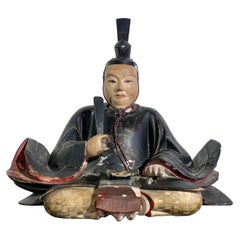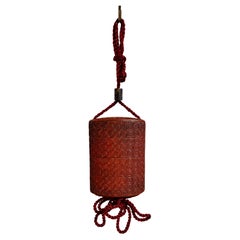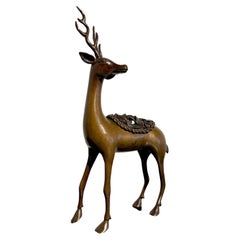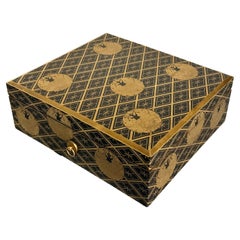Questions & Answers
Our trusted network of 1stDibs sellers answer common questions
What is the difference between a netsuke and a Okimono?
1 Answer
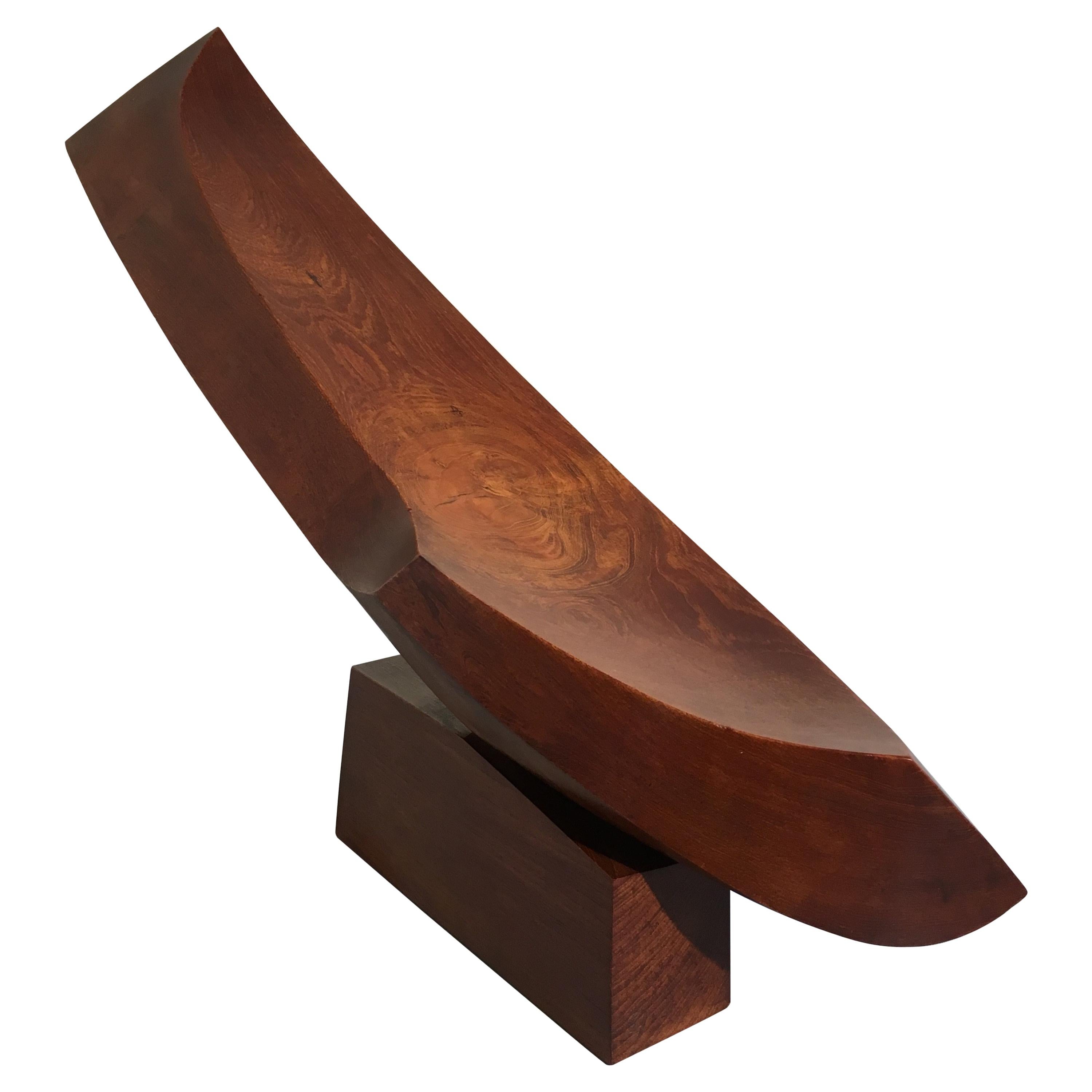
A netsuke is a small object, commonly made of carved ivory or wood, but also sometimes various other materials, including ceramic, bone, horn, coral, or even metals. Netsuke served both a decorative and functional purpose. Netsuke always have two holes, and were used as a cord fastener attached to an inro.
An okimono is simply a decorative sculpture or object, meant for display and to be admired. Okimono can be made of almost any material, and are usually much larger than netsuke.

Lotus GalleryMarch 17, 2021
Shop for Japanese Carved on 1stDibs
Japanese Carved and Lacquered Wood Shogun, Edo Period, 19th Century, Japan
Located in Austin, TX
An unusual Japanese carved wood, lacquer, and gilt decorated portrait sculpture of a shogun, Edo
Category
Antique Mid-19th Century Japanese Edo Sculptures and Carvings
Materials
Wood, Lacquer
Japanese Carved Cinnabar Lacquer Inro, Meiji Period, late 19th c, Japan
Located in Austin, TX
A good Japanese carved cinnabar three case inro with mixed metal ojime, Meiji period, late 19th
Category
Antique Late 19th Century Japanese Meiji Lacquer
Materials
Silver, Copper
Pair Japanese Carved and Lacquered Inari Foxes, Showa Era, Dated 1951, Japan
Located in Austin, TX
A delightful and mischievous pair of Japanese carved and lacquered wood Inari foxes, kitsune, dated
Category
Vintage 1950s Japanese Showa Sculptures and Carvings
Materials
Elm
Japanese Gilt Wood Fukukenjaku Kannon, Meiji Period or Earlier, Japan
Located in Austin, TX
An attractive and esoteric Japanese carved and gilt wood figure of Fukukenjaku Kannon, Amoghapasa
Category
Antique Early 1900s Japanese Meiji Sculptures and Carvings
Materials
Cypress
Pair of Japanese Gilt Wood Komainu, Guardian Lions, Early 20th Century, Japan
Located in Austin, TX
A charming and mischievous pair of Japanese carved, gilt and painted komainu, often mistaken for
Category
Vintage 1920s Japanese Showa Sculptures and Carvings
Materials
Glass, Cypress, Wood
Japanese Standing Gilt Buddha, Amida Nyorai, Edo Period, 18th century, Japan
Located in Austin, TX
An exquisite Japanese carved hinoki and gilt lacquered standing figure of Amida Nyorai, Amitabha
Category
Antique 18th Century Japanese Edo Sculptures and Carvings
Materials
Rock Crystal
Shop More furniture from Lotus Gallery on 1stDibs
Japanese Bronze Deer Incense Burner, Koro, Meiji Period, late 19th c, Japan
Located in Austin, TX
An elegant and ethereal Japanese bronze censer, koro, in the form of a deer, Meiji Period, late 19th century, Japan.
The deer is portrayed standing upon thin, spindly legs, one leg ...
Category
Antique Late 19th Century Japanese Meiji Sculptures and Carvings
Materials
Bronze
Kinkozan Satsuma Plate with Miniature Figures, Meiji Period, circa 1900, Japan
By Kinkozan
Located in Austin, TX
A very finely painted Japanese Satsuma plate with miniature figural paintings, signed Kinkozan for the Kinkozan workshops, Meiji Period, circa 1900, Japan.
The lovely plate crafted ...
Category
Antique Early 1900s Japanese Meiji Ceramics
Materials
Ceramic, Stoneware
Japanese Maki-e Lacquer Sutra Box with Peony Mon, Meiji Period, c 1900, Japan
Located in Austin, TX
A Japanese maik-e decorated black lacquer sutra box, kyobako, with peony mon design, Meiji Period, circa 1900, Japan.
The elegant lacquer box originally crafted to hold sutras, sacr...
Category
Antique Early 1900s Japanese Meiji Lacquer
Materials
Copper
Japanese Bronze Water Coupe, Eguchi as Fugen, Edo/Meiji Period, Japan
Located in Austin, TX
A very finely cast Japanese bronze water coupe in the form of the courtesan Eguchi riding an elephant, signed Kazutada, Edo to Meiji Period, mid 19th century, Japan.
The small and e...
Category
Antique Mid-19th Century Japanese Meiji Scholar's Objects
Materials
Bronze
Six Kinkozan Bowls with Birds and Flowers of the Months, Meiji Period, Japan
By Kinkozan
Located in Austin, TX
A very fine partial set of six Japanese Satsuma bowls decorated with flowers and birds of the months, signed Kinkozan, Meiji Period, circa 1900, Japan.
The set of six exquisitely pa...
Category
Antique Early 1900s Japanese Meiji Ceramics
Materials
Ceramic, Stoneware
Vintage Burmese Reclining Buddha, Carved, Lacquered and Gilt Wood, circa 1970's
Located in Austin, TX
A charming vintage Burmese Mandalay Style carved, lacquered, and gilt wood figure of a reclining Buddha, 1970's, Burma.
The delightful Buddha figure is portrayed resting comfortably...
Category
Vintage 1970s Burmese Sculptures and Carvings
Materials
Wood
Large Japanese Imari Fluted Charger, Edo/Meiji Period, Mid 19th Century, Japan
Located in Austin, TX
A large and impressive Japanese Imari porcelain fluted charger with scalloped rim, signed Kaji(chu?), Edo to Meiji Period, mid 19th century, Japan.
The magnificent Japanese Imari charger measures 25" in diameter, and is decorated in the typical imari palette of underglaze blue with overglaze red, orange, blue, and green enamels with gilt highlights. The large charger also features fluted sides and a scalloped gilt rim.
The design of the charger is centered on a central floral medallion with three large chrysanthemum blossoms and vegetal scrolls. Radiating out from the central medallion are various brocade patterned sections that roughly follow the shape of the fluting. Some larger sections feature images of cranes and minogame (turtles with long tails), both symbols of longevity, while other feature dragons and phoenix, symbols of authority and power. Four large reserves depict charming scenes of a scholar and his students within a bamboo grove having discourse and examining scrolls.
The back of the charger decorated in underglaze blue with bold floral and vegetal scrolls. With a three character inscription in underglaze blue reading Kaji(chu?) Sei.
The charger is fitted with an antique metal hanger...
Category
Antique Mid-19th Century Japanese Meiji Ceramics
Materials
Porcelain
